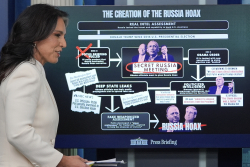Unlike older Soviet era attack submarines, the Yasen-M class boats were developed as multi-purpose vessels that can carry various weapons, including the most advanced new long-range Tsirkon hypersonic cruise missiles.
The Russian Navy currently operates seven Project 885M nuclear-powered attack submarines. Also known as the Yasen-M, the boats were developed to replace Moscow’s aging Soviet-era attack submarines and are considered to be among the best in the world.
Even more ominously for the United States, the Russian Navy could acquire even more of the highly capable submarines in the coming year. During a visit to the Russian naval base at Severodvinsk on Thursday, Russian President Vladimir Putin called for the continued serial production of the Yasen-M, which Putin described as the “backbone” of the Russian Navy’s “general-purpose forces.”
“That said, it is crucial to continue the serial production of the Yasen-M-class submarines,” Putin suggested, according to a report from state news agency Tass.
Putin further noted that four Project 885M boats are now under construction at the Sevmash shipyard, while two more will be laid down.
Unlike older attack submarines built during the late Soviet period, the Yasen-M class boats were developed as multi-purpose vessels that can carry various weapons, including the most advanced new long-range Tsirkon hypersonic cruise missiles. There are ten silos for vertically launched cruise missiles, and according to reports, the submarines can also be equipped with Kalibr-PL and Oniks cruise missiles as their basic strike weapons. The Kazan is also fitted with the UKSK (3P-14B) vertical launch system, comprising 8SM-346 modules.
The Project 885M attack submarines were not the only underwater cruisers to receive praise from the Russian head of state, who took the opportunity to highlight Moscow’s naval capabilities. Putin’s meeting with officials comes as the Russian Navy kicked off its most extensive military exercises in years, with the Baltic Fleet, Northern Fleet, Pacific Fleet, and Caspian Flotilla all engaged in exercises that will continue through Sunday.
Russia has all but abandoned large, yet costly, surface vessels such as the aircraft carrier Admiral Kuznetsov, which has been undergoing a seemingly endless refit. Recent reports suggest that the Kremlin has ended development on the carrier due to cost issues. Putin may be directing the Russian Navy to pivot to the one area where it continues to excel: submarines.
“In the coming years, our seaborne nuclear forces will receive another four Project Borei-A submarines in a planned procedure, two of which are at the stage of their construction. These strategic submarines of the latest generation are armed with Bulava ballistic missiles and also with other advanced weaponry,” Putin suggested.
His comments came just hours after he attended the ceremonial raising of the Russian Navy’s ensign on the latest Project 955A nuclear-powered ballistic missile submarine, the Knyaz Pozharsky (K-555). Named for Russian Prince Dmitry Mikhaylovich Pozharsky, who was known for his role in the Polish-Russian War (1609-1618), it is the eighth boat of the class to be commissioned. The submarine will be assigned to the Northern Fleet.
Two additional Borei-A submarines are currently under construction, and four more are planned but have yet to be laid down. Each can carry up to 16 Bulava intercontinental ballistic missiles equipped with multiple independently targetable reentry vehicle (MIRVed) warheads.
About the Author: Peter Suciu
Peter Suciu has contributed over 3,200 published pieces to more than four dozen magazines and websites over a thirty-year career in journalism. He regularly writes about military hardware, firearms history, cybersecurity, politics, and international affairs. Peter is also a Contributing Writer for Forbes and Clearance Jobs. He is based in Michigan. You can follow him on Twitter: @PeterSuciu. You can email the author: [email protected].
Image: Wikimedia Commons.
















